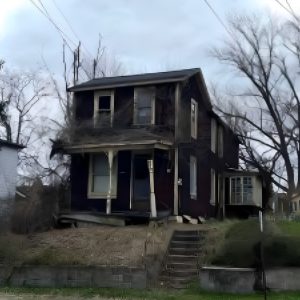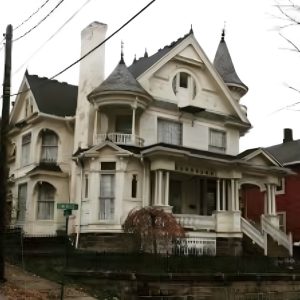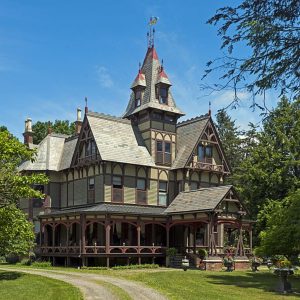From its foundation in 1925, the District Training School for the Mentally Retarded was less about treating those with physical or developmental disabilities than it was removing them from sight. The school’s Laurel, Maryland site was chosen by Congress for its rural location and to replace the appallingly named Washington Home for Colored Idiots, which residents of the nearby Logan Circle neighborhood had pressured lawmakers to close. The new training school’s campus comprised approximately 300 acres and 22 buildings, including a cafeteria, a recreation center, a gym, a theater, a baseball field, a hospital, a chapel, administrative offices, school buildings, dormitories, and a farm. Described as state of the art, programs like the ones held in the farm colony were designed to teach residents useful skills that would eventually help them find jobs in the region, such as tending crops and milking cows.
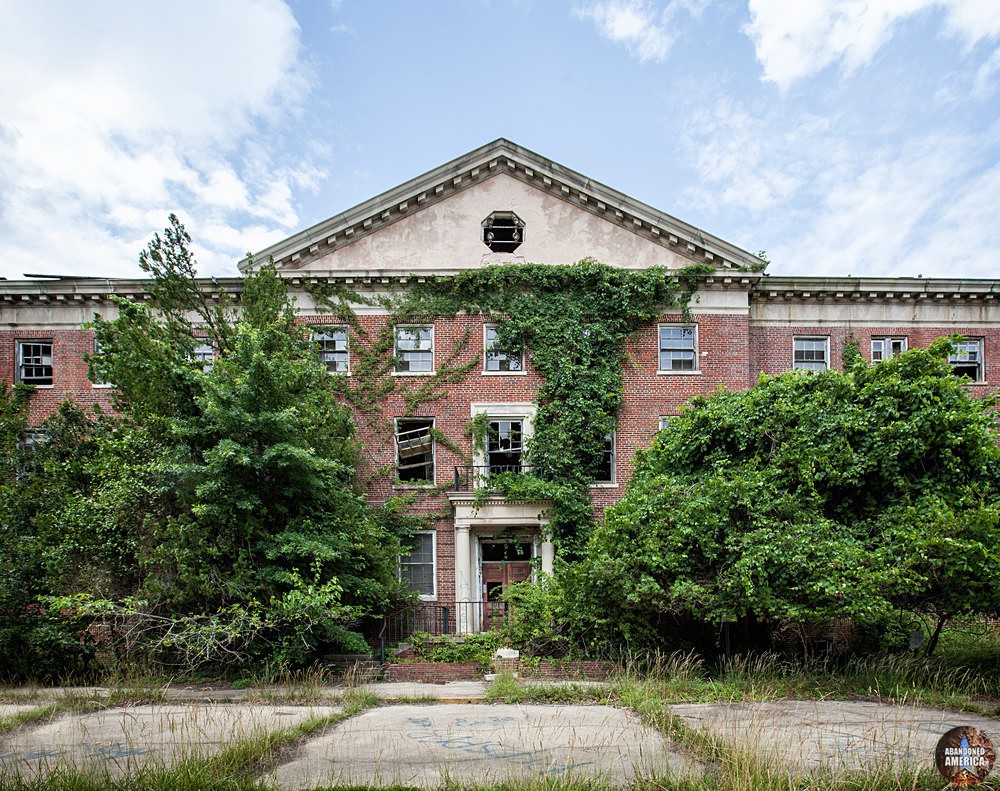 The abandoned hospital building at Forest HavenIt’s difficult to pinpoint exactly where the District Training School made the transition from a relatively innocuous treatment and training center to what one investigating attorney described as “the deadliest known example of institutional abuse in recent American history.” In the beginning, at least, things appeared uneventful. Then, in 1954 a man was arrested in Pennsylvania on white slavery charges for bringing a resident of the school to York ‘for purposes of prostitution’, although there’s nothing indicating that this was anything more than an isolated incident. Around that time, a Frederick, Maryland newspaper carried a story about a boy who was committed to the school after living with a pack of stray dogs for over two weeks because he was afraid of being whipped at home.
The abandoned hospital building at Forest HavenIt’s difficult to pinpoint exactly where the District Training School made the transition from a relatively innocuous treatment and training center to what one investigating attorney described as “the deadliest known example of institutional abuse in recent American history.” In the beginning, at least, things appeared uneventful. Then, in 1954 a man was arrested in Pennsylvania on white slavery charges for bringing a resident of the school to York ‘for purposes of prostitution’, although there’s nothing indicating that this was anything more than an isolated incident. Around that time, a Frederick, Maryland newspaper carried a story about a boy who was committed to the school after living with a pack of stray dogs for over two weeks because he was afraid of being whipped at home.
 One of Forest Haven’s abandoned cottages, overgrown by trees. There was little left of the interior to identify its use.One of the most widespread stories about Forest Haven was in 1961 when a “beer drinking, trumpet-playing white rabbit” named Zsa Zsa was sent by a magician to the White House as a present for three year old Caroline Kennedy. Zsa Zsa was quickly regifted to The District Training School’s hospital, The District of Columbia Children’s Center, unfortunately without verifying whether it could actually play the first five bars of “The Star Spangled Banner” on the toy trumpet provided. Another incident in 1961 that happened at almost the exact same time received much less news coverage: a 17-year-old African American resident was scalded to death while locked in a barred detention room after a fight. A pipe which carried “300 degree steam and boiling water under 55 pounds of pressure” broke while he was left unsupervised in the room. He was pronounced dead at the Children’s Center. Little other information on the incident was given. Patient escape stories were more common, including an incident in 1973 where four employees were kidnapped at gunpoint by three men trying to break a resident out of the facility.
One of Forest Haven’s abandoned cottages, overgrown by trees. There was little left of the interior to identify its use.One of the most widespread stories about Forest Haven was in 1961 when a “beer drinking, trumpet-playing white rabbit” named Zsa Zsa was sent by a magician to the White House as a present for three year old Caroline Kennedy. Zsa Zsa was quickly regifted to The District Training School’s hospital, The District of Columbia Children’s Center, unfortunately without verifying whether it could actually play the first five bars of “The Star Spangled Banner” on the toy trumpet provided. Another incident in 1961 that happened at almost the exact same time received much less news coverage: a 17-year-old African American resident was scalded to death while locked in a barred detention room after a fight. A pipe which carried “300 degree steam and boiling water under 55 pounds of pressure” broke while he was left unsupervised in the room. He was pronounced dead at the Children’s Center. Little other information on the incident was given. Patient escape stories were more common, including an incident in 1973 where four employees were kidnapped at gunpoint by three men trying to break a resident out of the facility.
The House of Representatives officially changed the name of the school to Forest Haven in 1963, and amended the terms “feeble-minded” to “mentally retarded” and “inmate” to “patient”. The same decree made it possible for the District of Columbia Department of Public Welfare to forego the court order and hearing previously necessary for admission and instead perform intake at its discretion. By 1969 Forest Haven’s population had reached 1,250, and the cost of care per day for each resident was $9.75. At some point in the 1960s funding was slashed and recreation and athletic programs were cut.
As time progressed Forest Haven gained a reputation as less of a program for treatment and care than a dumping ground for anyone that the District of Columbia couldn’t be bothered to deal with. People who were hearing impaired, dyslexic, or epileptic were put into cottages with the developmentally disabled and often their cognitive abilities regressed. One particularly egregious instance happened in 1974 when a local orphanage was closed and 20 children were classified as “retarded” so they could be moved there indefinitely. In the late 1970s the story came to light of a woman who had been classified as mildly retarded in 1933 when her husband left her. She spent nearly 45 years confined at Forest Haven. Her children were told she abandoned them.
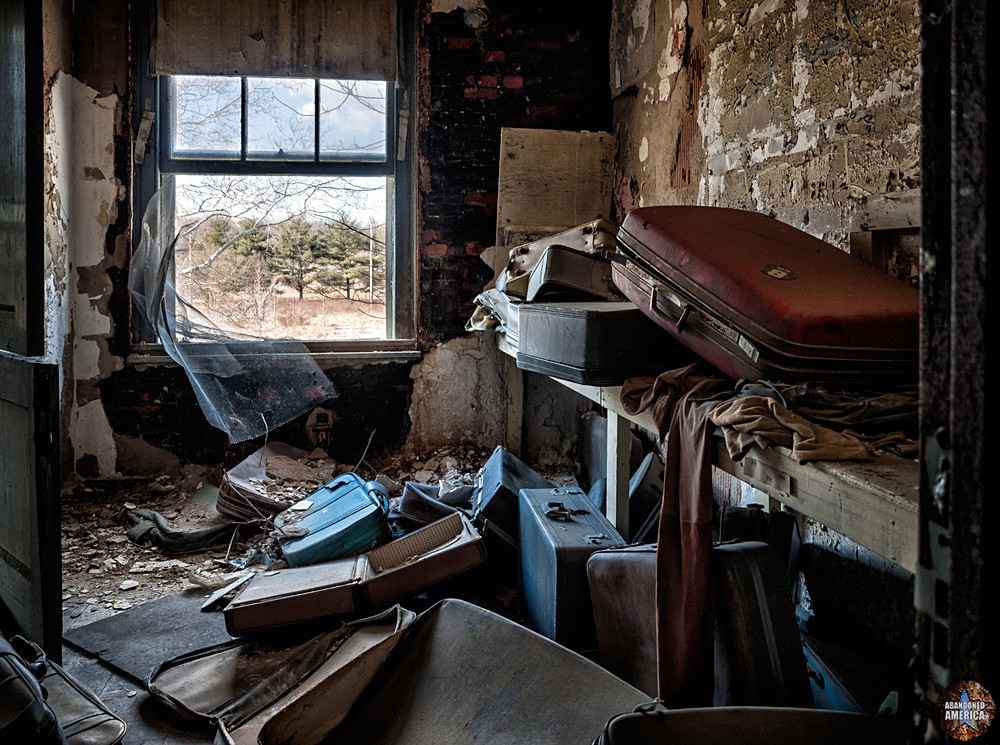 Residents’ suitcases left behind in an abandoned dormitory at Forest HavenThe push for deinstitutionalization in the 1970s was the beginning of the end for many of the nation’s asylums and institutions. Public sentiment had begun to shift and the prevailing belief was now that community based treatment was more humane and provided better results. Terrible stories, such as the suicides of four youths in seclusion at Forest Haven, leaked out into the community. The bombshell was a landmark class-action lawsuit, Evans, et al. vs. Washington, alleging that inhumane treatment at Forest Haven violated the constitutional rights of residents. Filed by Betty Evans in response to the death of her 18-year-old daughter Joy, the suit uncovered a story of abuse and neglect so horrible it is hard to fathom.
Residents’ suitcases left behind in an abandoned dormitory at Forest HavenThe push for deinstitutionalization in the 1970s was the beginning of the end for many of the nation’s asylums and institutions. Public sentiment had begun to shift and the prevailing belief was now that community based treatment was more humane and provided better results. Terrible stories, such as the suicides of four youths in seclusion at Forest Haven, leaked out into the community. The bombshell was a landmark class-action lawsuit, Evans, et al. vs. Washington, alleging that inhumane treatment at Forest Haven violated the constitutional rights of residents. Filed by Betty Evans in response to the death of her 18-year-old daughter Joy, the suit uncovered a story of abuse and neglect so horrible it is hard to fathom.
Joy Evans was committed to Forest Haven at 8 years old. Her parents were unable to provide 24-hour care because of their work schedules, schools would not take her, and private schools were too expensive. During Joy’s years at Forest Haven Betty observed injuries on her daughter that “ranged from chipped teeth to scratches, lacerations and bruises all over her body. “ On one occasion, Joy’s back was raw from urine burns while she was restrained on a rubber sheet. Betty wrote in an affidavit, “Dogwood, the cottage where Joy lived, was a veritable snake pit… I once witnessed a nurse open the cottage door only to find 80 half-clad screaming women come running to the door; the nurse quickly closed it shut.” According to the lawsuit, “Staff members locked dozens of residents, naked except for adult-sized diapers, in rooms stripped of furniture other than wooden benches.”
Joy died from improper feeding, the cause of death of dozens of others. Residents were often fed baby food while lying down, which led to vomiting, gastrointestinal bleeding, and aspirational pneumonia, which is when food, liquid, or vomit is inhaled into the lungs causing a fatal infection or choking. The father of a 22-year-old who died of aspirational pneumonia at Forest Haven stated, “They wouldn’t even give him time to swallow what he had in his mouth. They would be pouring it in him like they were pouring water down his throat and it would all just come back out of his mouth and nose.” Such treatment was more likely the result of ignorance and haste than of intentional cruelty; there was always the threat of being fired if eight to ten people were not fed by a staff member in the period it would take to properly feed one. In Murray Waas’ heartbreaking expose for the Washington Post, an occupational therapist was quoted as saying “Nobody ever instructed them that it was wrong to feed the residents lying down. The sad thing is that many of the workers were the only people in the world who cared about many of the clients.” As a nurse tenderly cared for a resident while Waas watched, she concluded by feeding him while was lying down.
 Adult cribs left in the basement of one of Forest Haven’s abandoned buildingsWhen the Justice Department joined the lawsuit and the case was settled in 1978, it must have seemed like a great victory. Forest Haven was to be closed and the residents were to be moved to group homes and fed properly. Despite the city government’s promise, Forest Haven would remain open until October 14, 1991, continuing to kill residents with improper care and feeding the entire time. A proposal to spend $24,698 to train workers in proper feeding technique was shot down due to lack of funds, and the Justice Department’s efforts to expedite the closure because of the deaths were met with hardened indifference from federal district Judge John Pratt, who reasoned ““these people… are not in the best of health probably, any of them.”
Adult cribs left in the basement of one of Forest Haven’s abandoned buildingsWhen the Justice Department joined the lawsuit and the case was settled in 1978, it must have seemed like a great victory. Forest Haven was to be closed and the residents were to be moved to group homes and fed properly. Despite the city government’s promise, Forest Haven would remain open until October 14, 1991, continuing to kill residents with improper care and feeding the entire time. A proposal to spend $24,698 to train workers in proper feeding technique was shot down due to lack of funds, and the Justice Department’s efforts to expedite the closure because of the deaths were met with hardened indifference from federal district Judge John Pratt, who reasoned ““these people… are not in the best of health probably, any of them.”
It was difficult to find lawyers to represent residents; the damages in wrongful death lawsuits are dictated by how much the person would have conceivably earned for the rest of their lives, and residents of Forest Haven would be expected to earn little, if any, money. Betty Evans’ conclusion, and that of Murray Waas’ article, was that the city government and the entire community were to blame for the callousness towards Forest Haven’s residents, and it certainly seems like a reasonable assumption. This was a facility where a staff member embezzled $40,000 from residents, where residents lost their teeth because of inadequate dental care and vomiting from improper feeding, where residents died from bedsores from being kept indefinitely in adult cribs. Little more happened in response to repeated warnings of deadly neglect than the unceremonious dumping of victims’ bodies via a maintenance truck into mass graves, their passing marked with nothing more than a numbered metal disk. How could it seem anything else than a malevolent lack of concern for the children and adults in our midst who are least able to articulate abuse and defend themselves?
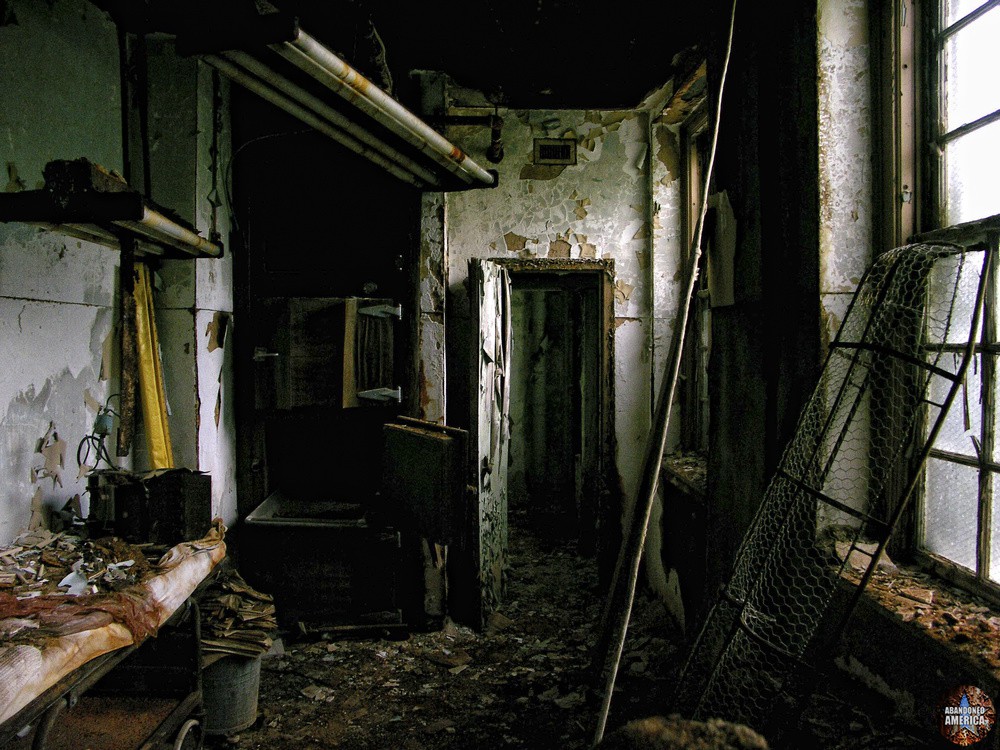 The rotting morgue at Forest Haven. A Stokes Basket is visible leaning against the window.Forest Haven was one of the earliest abandoned sites that I visited. I wasn’t aware yet of how profoundly terrible its past was, but it quickly impressed itself upon me as spectacularly eerie place. Nestled away in the woods between a juvenile detention facility called the Oak Hill Youth Center, the Woodland Job Corps Center, and the headquarters for the National Security Agency, odd tones and garbled announcements pierced the silence at frequent intervals. I didn’t know yet about the graves on campus that had been uncovered by erosion or the tragic detachment from the well-being of residents that led to Forest Haven’s closure. When I emerged from the trees and entered the Curley Building, a nearly 70,000 square foot structure built in 1971 to house 200 of the most disabled residents, I was confronted with old schoolbooks, gruesomely decaying paintings of Peanuts characters, and the pervasive adult cribs I’d find scattered throughout the campus.
The rotting morgue at Forest Haven. A Stokes Basket is visible leaning against the window.Forest Haven was one of the earliest abandoned sites that I visited. I wasn’t aware yet of how profoundly terrible its past was, but it quickly impressed itself upon me as spectacularly eerie place. Nestled away in the woods between a juvenile detention facility called the Oak Hill Youth Center, the Woodland Job Corps Center, and the headquarters for the National Security Agency, odd tones and garbled announcements pierced the silence at frequent intervals. I didn’t know yet about the graves on campus that had been uncovered by erosion or the tragic detachment from the well-being of residents that led to Forest Haven’s closure. When I emerged from the trees and entered the Curley Building, a nearly 70,000 square foot structure built in 1971 to house 200 of the most disabled residents, I was confronted with old schoolbooks, gruesomely decaying paintings of Peanuts characters, and the pervasive adult cribs I’d find scattered throughout the campus.
As I crossed the road to enter the children’s hospital, a lone wheelchair sat out front, nearly swallowed by the unkempt grass, and the deterioration inside the hospital was severe. Rusted light fixtures hung at odd angles, discarded toys littered the rooms, and in the remains of the dental offices bottles of anesthetic sat next to the twisted examination chairs. The basement was shrouded in darkness, and the drop tiles in the ceiling had fallen out and blended into a dirty muck on the ground. It was there that I found the morgue, still relatively intact. A Stokes basket, used by firefighters and search and rescue missions, leaned against the wall. It seemed improbable that it was used for anything other than transporting bodies. As I photographed the morgue I noticed dozens of small pairs of glasses around my feet in the sludge, and it dawned on me that they had most likely all belonged to dead children.
 The dental offices in Forest Haven’s abandoned hospitalEach time I returned to Forest Haven over the years, I found new unsettling details. There was the spring-mounted horse lost in the weeds by the playground, the suitcases stacked in a storage room that had held the residents’ belongings when they arrived, the empty shoes that were in so many areas. There were the little crutches and braces that the children used and the ubiquitous large cribs in basements and hallways. Paperwork carpeting the offices gave glimpses into unimaginable things. In one document a dentist angrily complained about the impossible working conditions and the awful effects on the residents: “Her primary dental problem is advanced periodontal disease resulting from atrocious oral hygiene. She has extremely severe gingivitis. Her last prophylaxis was done on 6-1-89. At present the teeth are covered with a thick layer of plaque, [illegible], food debris. In addition to the periodontal disease this has also produced a revolting odor to her breath… There is no hygienist taking care of these clients. Without a hygienist this work cannot be done. We can do some but not all of them. We must select the worst cases and do them first. A hygienist should have been hired 4 years ago.” Another report described a girl with hydrocephalus and osteogenesis imperfecta (brittle bone syndrome). She wanted to go out and play with the other children but had to be kept in the crib. If released from confinement, there was a high risk that her bones would snap.
The dental offices in Forest Haven’s abandoned hospitalEach time I returned to Forest Haven over the years, I found new unsettling details. There was the spring-mounted horse lost in the weeds by the playground, the suitcases stacked in a storage room that had held the residents’ belongings when they arrived, the empty shoes that were in so many areas. There were the little crutches and braces that the children used and the ubiquitous large cribs in basements and hallways. Paperwork carpeting the offices gave glimpses into unimaginable things. In one document a dentist angrily complained about the impossible working conditions and the awful effects on the residents: “Her primary dental problem is advanced periodontal disease resulting from atrocious oral hygiene. She has extremely severe gingivitis. Her last prophylaxis was done on 6-1-89. At present the teeth are covered with a thick layer of plaque, [illegible], food debris. In addition to the periodontal disease this has also produced a revolting odor to her breath… There is no hygienist taking care of these clients. Without a hygienist this work cannot be done. We can do some but not all of them. We must select the worst cases and do them first. A hygienist should have been hired 4 years ago.” Another report described a girl with hydrocephalus and osteogenesis imperfecta (brittle bone syndrome). She wanted to go out and play with the other children but had to be kept in the crib. If released from confinement, there was a high risk that her bones would snap.
There was Spruce Cottage, which had been surrounded by ringlets of razor wire and reused by the Oak Hill Youth Center to detain violent females. I photographed that shortly after it was closed, when there were still full pill bottles in the medicine carts and faceless CPR dummies with black voids for faces staring down the darkened hallway. Oak Hill had its own horrors. Aside from the general squalor, a 1989 investigation concluded staff had “wounded or beaten juveniles with a brick, knife, chair, milk cartons and fists, causing broken teeth and noses, a dislocated shoulder, kidney injuries and eyes swollen shut.” After Oak Hill’s closure in 2009 another youth detention center named New Beginnings opened elsewhere on the property.
I’d like to believe the days of the ill-fated vacation Forest Haven residents took in 1976 to Wildwood, New Jersey are long gone. Local residents surrounded their motel and threatened to burn it because they “didn’t want any colored or retarded” to stay there, and the local police failed to do anything to protect them. Their bus was pelted with rocks as they left. The closure of the facility in 1991, though, is not so long ago, and thoughtless visitors to the campus have painted the words “RETARDS” on some of the buildings much more recently. After Forest Haven closed the residents were moved to underfunded, poorly supervised group homes described as “roach dappled” and full of broken furniture and doors. A Washington Post article by Katherine Boo from 1999 told the story of one former resident who was raped repeatedly by a sexual predator who was placed in the room next to his. The victim eventually tried to commit suicide by running out into traffic.
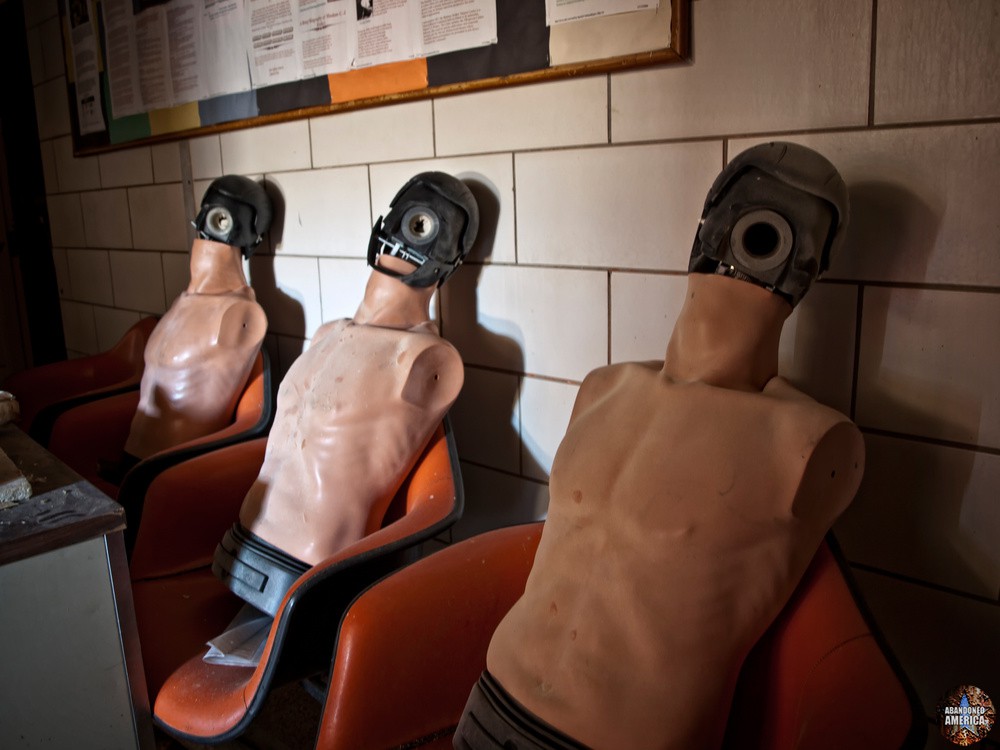 Faceless CPR dummies sit in a darkened corridor in a former Oak Hill Youth Center buildingThe same neglect, lack of oversight, unchecked abuse, and public indifference continued as for-profit entrepreneurs who lived in multimillion-dollar villas operate group homes that claim not to be able to afford toilet paper for the residents. When Forest Haven was open, a doctor whose license was suspended provided grossly inadequate care resulting in the death of residents. The licensing board had previously declared his continued practice posed a “grave risk and imminent danger to the health, safety and welfare of the citizens of Maryland.” According to Boo, after Forest Haven closed a “convicted embezzler, a psychologist who billed the government for treating the dead and a man who paid go-go dancers as ‘group home consultants’ were among those paid by the District to run group homes and therapeutic programs.” The city was billed for “therapy programs” that included group home residents shoveling manure at the owner’s manor.
Faceless CPR dummies sit in a darkened corridor in a former Oak Hill Youth Center buildingThe same neglect, lack of oversight, unchecked abuse, and public indifference continued as for-profit entrepreneurs who lived in multimillion-dollar villas operate group homes that claim not to be able to afford toilet paper for the residents. When Forest Haven was open, a doctor whose license was suspended provided grossly inadequate care resulting in the death of residents. The licensing board had previously declared his continued practice posed a “grave risk and imminent danger to the health, safety and welfare of the citizens of Maryland.” According to Boo, after Forest Haven closed a “convicted embezzler, a psychologist who billed the government for treating the dead and a man who paid go-go dancers as ‘group home consultants’ were among those paid by the District to run group homes and therapeutic programs.” The city was billed for “therapy programs” that included group home residents shoveling manure at the owner’s manor.
Care for those with severe developmental and physical disabilities is tremendously challenging and requires an almost superhuman level of compassion and vigilance. In situations like that of the girl with osteogenesis imperfecta, our own helplessness to resolve the root illnesses makes us confront questions that have no easy answers, and empathy requires contemplating things that can be very painful. People who are marginalized and may not be able to report their concerns to others are the easiest for predators of any kind to abuse. When the state schools were founded it was hoped that they would provide opportunities for care and supervision that the families were sometimes unable to, where trained staff could help residents learn skills and receive a better standard of treatment than what their homes and communities could provide. I believe Betty Evans was right, that an overall apathy towards the well-being of the less fortunate among us turned this dream into a nightmare that claimed many lives.
The bronze plaque that used to be in front of the District of Columbia Children’s Center read, “Yet while I live, let me not live in vain.” It’s an interesting statement, one that takes on different meanings when applied to the lives of the residents of Forest Haven, its staff, and the overall lifespan and shattered remains of Forest Haven itself. After all, if what happened at Forest Haven and afterwards doesn’t inspire a public commitment to monitor residential treatment facilities of any type and to demand that they are clean, humane, and well-run, all of the suffering was for nothing.
